Author: DONOVAN CHOY; Translator: Vernacular Blockchain
The restaking war is heating up. Challenging EigenLayer's monopoly is another new protocol, Symbiotic, supported by Lido. This latest entrant brings competitive advantages in protocol design and business development cooperation. Before we dive into the new competitive dynamics in the restaking field, we need to first understand the key risks in the existing system.
1. Current problems encountered by Restaking
Here is how restaking works today: Bob deposits ETH/stETH into a liquidity restaking protocol like Ether.Fi, Renzo, or Swell, which then delegates it to EigenLayer's node operators, who then use it to protect one or more AVSs to bring some benefits to Bob.
There is a compounding risk in the existing system, which lies in its one-size-fits-all nature. EigenLayer's node operators manage thousands of assets, which are used to validate multiple AVS. This means that Bob does not have any say in the risk management of the AVS selected by the node operator.
To be sure, Bob can try to choose a "safer" node operator, but these operators are in fierce competition with hundreds of other operators, all wanting to obtain your re-pledged collateral, and all incentivized to validate as many AVS as possible to maximize your returns.
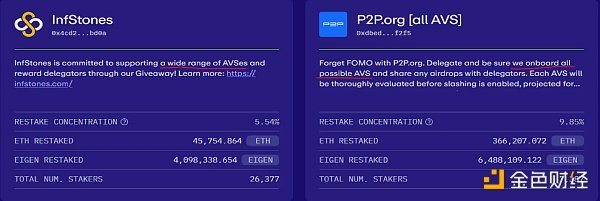
This competitive state may lead to a bad result that no one wants to see: each node operator will protect the AVS that they think is foolproof. When the AVS is compromised and a slashing event occurs, no matter which operator Bob chooses, he will be affected.
2. Introducing Mellow Finance
Mellow partially solves this problem. Mellow, known as "modular LRT", is a middleware layer in the re-pledge stack that provides customizable liquidity re-pledge vaults. With Mellow, anyone can become their own Ether.Fi or Renzo and launch their own LRT vault. These third-party "curators" on Mellow will have full control over which Restaking assets are accepted, and users can choose and pay fees based on their risk appetite.
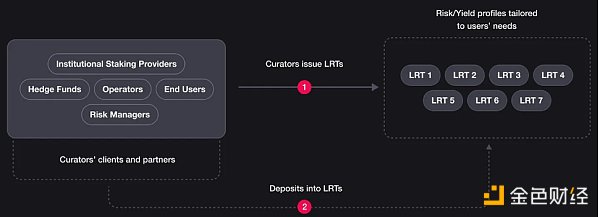
Here is a ridiculous example: Alice is an avid DOGE enthusiast who is looking for returns on her DOGE assets. She sees a vault called DOGE4LYFE on Mellow. She deposits her DOGE into a DOGE4LYFE vault, earns the restaking yield, pays a small fee to the operator, and gets an LRT token called rstDOGE, which she can use as collateral in DeFi. This is not currently possible because EigenLayer does not allow DOGE to be whitelisted. Even if Sreeram eventually accepts DOGE, the above incentive imbalance problem faced by node operators will still exist.
If this sounds familiar, it’s because similar services are already provided in DeFi lending by protocols like Morpho, Gearbox, or Rari’s now-deprecated Fuse protocol, which DeFi veterans from the previous cycle may remember. For example, Morpho allows the creation of lending vaults with customized risk parameters. This allows users to borrow assets from vaults with unique risk characteristics instead of borrowing assets from a single risk pool on Aave. In the upcoming V4 upgrade, Aave also plans to upgrade the protocol with segregated lending pools.
Since Mellow is merely a middleware resting protocol, the assets in its vault must be rested somewhere. Interestingly, Mellow chose to strategically partner with the upcoming resting protocol Symbiotic instead of EigenLayer. Symbiotic is backed by Lido’s venture capital arm cyber•Fund and Paradigm (the latter is also a Lido backer).
Unlike EigenLayer or Karak, Symbiotic allows multi-asset deposits of any ERC-20 token, making it the most permissionless protocol to date. Anything from ETH to the most extreme memecoin can be used as resting collateral to secure AVS. This could open the floodgates for excessive speculation in cryptocurrencies: imagine a Mellow vault composed of resting DOGE collateral to secure Symbiotic’s AVS.
3. Mellow x Symbiotic x Lido Strategy

While this is all technically possible, it misses the point of the modular nature of the Mellow product, which allows for unlimited re-staking yield combinations designed by third-party vault curators. Here, the rationale for Mellow's integration with Symbiotic becomes clear, as assets are still restricted on other Restaking protocols such as EigenLayer or Karak.
To date, a large number of curators have joined Mellow and opened their own LRT vaults. Unsurprisingly, most curators use stETH as collateral for staking, given Lido’s deep partnership with Mellow (more on that later).
The exceptions are two Ethena vaults, which accept sUSDe and ENA. Yes, Mellow managed to attract Ethena — its first sUSDe vault is already full.
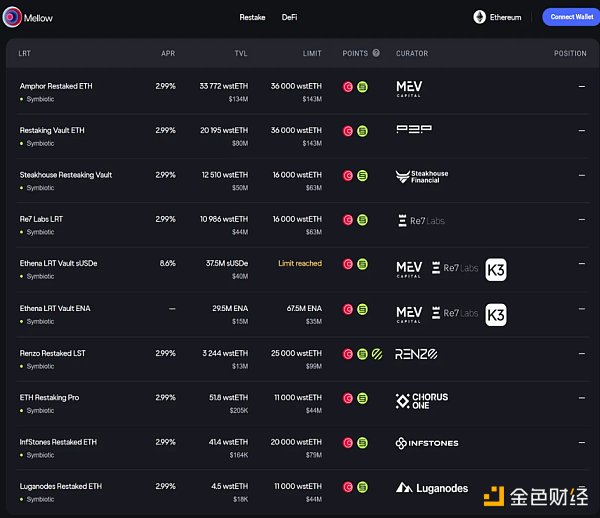
The final part of Mellow’s strategy lies in its participation in the recently announced “Lido Alliance,” an official guild aligned with the Lido project. Mellow benefits from having direct access to stETH deposits from Lido, which explains why it has pledged 10% of its MLW Token supply (100B total) for the partnership. On the other hand, Lido also benefits from this as it hopes to recapture stETH capital from its liquidity Restaking competitors. Since the outbreak of Restaking in 2024, Lido's growth has stagnated as liquidity has been drawn away from LRT competitors.
4. Market transaction volume
Symbiotic's competitive advantage over EigenLayer or Karak comes from its tight integration with Lido. The idea is that Lido's node operators can issue their own LRT through Mellow/Symbiotic and internalize additional wstETH yield layers in the Lido ecosystem, thereby creating value returns for the Lido DAO.
Now depositing stETH into the Mellow vault can obtain the following four levels of income:
Symbiotic has been open for deposits for only two weeks and has attracted a total locked value of US$316 million.

Mellow, on the other hand, has attracted a cumulative total value locked (TVL) of $374. It’s still early days for both, but it’s a positive sign that Lido is on its way to success.
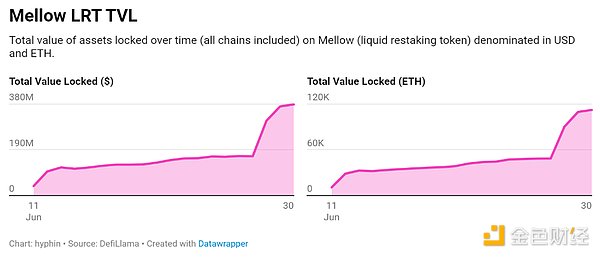
As of June 20, four Mellow pools have been launched on Pendle:
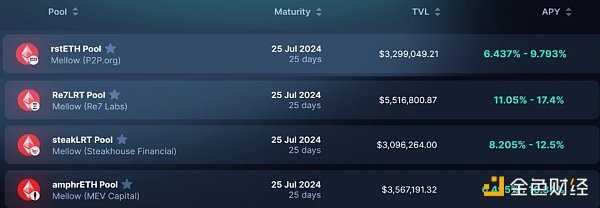
Currently, these pools only accept Mellow points until Symbiotic's cap is raised. To compensate, Mellow is awarding triple the points for deposits (compared to 1.5 times for deposits directly on Mellow). Given that the expiration date is very short, the liquidity of these pools is also quite low, so if you try to buy YT, the slippage will be quite high. The best strategy at the moment may be to choose PT fixed income, and the annualized yield of these pools ranges from 17% to 19% (sorted by the highest fixed income).
5. Overview of the Restaking Field
The competition in the Restaking market has become complicated, let's quickly summarize it. As of today, there are three main Restaking platforms. Arranged by total locked value (TVL), they are EigenLayer, Karak, and Symbiotic.
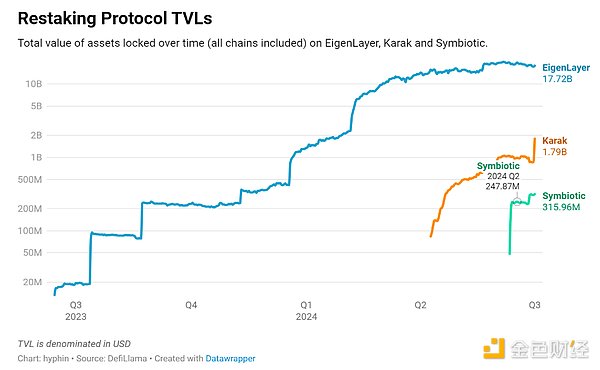
All three Restaking platforms offer services to sell security to AVS. Due to Ethereum's dominance and deep liquidity, stETH becomes the obvious staking choice for EigenLayer. Karak, which we have previously reported on, has expanded the Restaking collateral collection to stablecoins and WBTC collateral beyond ETH LSTs. Now, Symbiotic is pushing the envelope by allowing the use of any ERC-20 collateral.
Meanwhile, LRT protocols such as Ether.Fi, Swell, and Renzo have spotted the opportunity and started competing with Lido for collateral through their own points campaigns.

Lido enjoyed the dominance of stETH in DeFi, but for the first time began to lose market share to the LRT protocol. For Lido, the simple response might have been to transform stETH from LST to LRT assets, but it chose to keep stETH as LST and cultivate its own re-staking ecosystem within it. To this end, Lido is supporting Symbiotic and Mellow as part of the "Lido Alliance" to provide a permissionless, modular re-staking product. Summarizing the sales idea:
Dear project parties, don’t wait for EigenLayer to whitelist your tokens, come to Symbiotic and launch your own LRT without permission.
Dear users, stop depositing your wstETH in LRT competitors, give it to Mellow and get better risk-adjusted returns.
6. Summary
As competition in the re-staking field intensifies, here are some points worth considering:
1) AVS demand and the necessity of a re-staking platform
AVS demand: Currently, only EigenLayer has active AVS. Of the total locked value (TVL) of about 5.33 million ETH, about 22.6 million ETH is re-staking in 13 AVS, assuming a collateral ratio of about 4.24 times.
Is the number of re-pledge platforms necessary: The main trend among re-pledge platforms is to integrate as many re-pledge assets as possible. Late competitors to EigenLayer such as Karak differentiate themselves by using WBTC collateral, stablecoins, and Pendle PT assets. Symbiotic goes a step further by allowing any ERC-20 token to be used, but leaves asset curation to third-party Mellow vault creators. Although EigenLayer is the most stringent, it still maintains a huge lead in TVL. Whether non-ETH assets are allowed for chain security remains to be discussed.
2) The prospects of LRT protocols
Integration with Symbiotic: There is nothing stopping them from also integrating with Symbiotic, and in fact Renzo has already done so. Symbiotic is designed to be as permissionless as possible, and LRT protocols have no reason to be loyal to EigenLayer, and they will want to take some market share in the Lido re-staking ecosystem, especially before Mellow gains a monopoly in this secondary market.
Competitive relationship: Lido's goal is to reaffirm the dominance of stETH, and both Symbiotic and Mellow are projects backed by this liquid staking giant. This goal is fundamentally contradictory to the strategy of introducing eETH, ezETH, swETH, etc. to Symbiotic. It will be interesting to see how Lido balances this.
3) Impact on developers
It becomes easier to launch the economic security of your own chain: EigenLayer makes this process convenient, but the permissionless vault on the Mellow x Symbiotic stack makes it even easier. Major players like Ethena have announced plans to allow sUSDe and ENA to be re-staked in Symbiotic to secure its upcoming Ethena chain, rather than expecting EigenLayer or Karak to whitelist ENA as re-staked collateral.
4) Impact on Lido DAO and LDO Token Holders
DAO Revenue: The DAO collects a 5% fee from all stETH staking rewards, which will be distributed between node operators, the DAO, and the insurance fund. Therefore, the more ETH staked in Lido (rather than in the LRT protocol), the more income the DAO will receive. However, Lido's efforts to build its own re-staking ecosystem have not brought a clear value accumulation path for LDO Token, and LDO remains just a governance token.
 Catherine
Catherine















